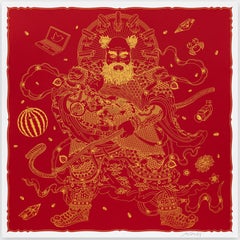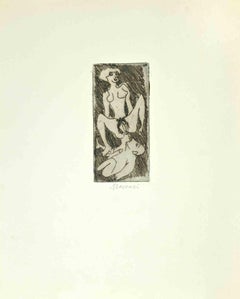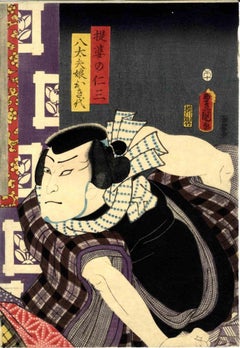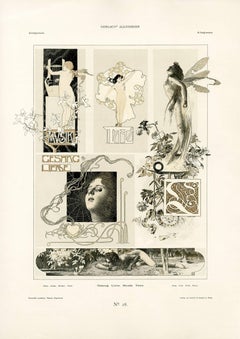People Figurative Prints
to
4,671
14,825
4,803
4,203
1,792
1,040
Overall Width
to
Overall Height
to
9,859
4,411
1,628
1,412
953
765
715
495
285
219
181
59
32
7
665
272
252
228
219
2,201
5,243
15,864
3,447
239
519
1,163
938
816
1,371
1,954
3,069
1,489
686
1,805
17,435
8,423
778
26,758
14,672
10,622
9,014
7,717
6,942
4,595
4,159
2,385
2,043
1,932
1,846
1,623
1,458
1,435
1,425
1,406
1,282
1,204
1,108
10,493
8,064
3,624
2,013
1,605
2,438
12,928
11,826
10,355
Art Subject: People
Guardian
By Ai Weiwei
Located in London, GB
Guardian, 2024
60 x 60 cm
edition of 1601
hand-signed and numbered by the artist
Understanding the print... see image 4.
01 · Sunflower seeds
Used in ceramic form by Weiwei for his ...
Category
2010s Contemporary Figurative Prints
Materials
Glitter, Screen
$2,350
Erotic Scene - Etching by Mino Maccari - Mid-20th Century
By Mino Maccari
Located in Roma, IT
Erotic Scene is an Etching and Drypoint realized by Mino Maccari in the Mid-20th Century.
Hand-signed in the lower part.
Good conditions.
Mino Maccari (Siena, 1924-Rome, June 16, ...
Category
Mid-20th Century Modern Figurative Prints
Materials
Paper, Etching, Drypoint
Portrait of Nakamura Fukus - Woodcut Print by Utagawa Kunisada - 1850s
Located in Roma, IT
Portrait of the actor Nakamura Fukusuke I is an original modern artwork realized by Utagawa Kunisada in 1858.
Woodcut print Oban Format from a tryptich.
Portrait of the actor Nakam...
Category
19th Century Modern Figurative Prints
Materials
Woodcut
Original Durham England British Railways Vintage Travel poster
Located in Spokane, WA
Original Durham, England 1953 British Railways vintage poster. Conservation linen backed in excellent condition; it is ready to frame.
This vintage poster features a modern mid-century design that adds nostalgia and charm to any space.
The image on the poster is an original 1953 artwork by Anthony Frank Kersting, showcasing two women sitting under a tree by the river, engaged in fishing.
Durham England Theme: The poster highlights the beauty of Durham, England, with the iconic Durham cathedrals showcased prominently in the center of the image, surrounded by white clouds.
Perfect for Decoration: This vintage poster is perfect for decorating any space, whether it's your home, office, studio, or any other area that could benefit from a touch of vintage charm.
Unique Collectible: As an original vintage poster, this unique collectible can add value to any vintage art collection...
Category
1950s American Realist Landscape Prints
Materials
Offset
Good Memories, Home 1982
Located in San Francisco, CA
This artwork titled "Good Memories, Home 1982" 1982 is an color etching by noted Austrian artist Josef Eidenberger, 1899-1991. It is hand signed, titled, dated and resigned a second time in pencil by the artist. The plate mark size is 10.25 x 7 inches, framed size is 18 x 14.10 inches. Custom framed in a wood and silver color frame, with green matting and brown filet. It is in excellent condition.
About the artist.
Josef Eidenberger was born in 1899 in the little town of Goisern, Austria,he began his artistic career as a landscape painter. In 1923 he enrolled in the famed Graphic Academy of Art in Vienna and studied under Professor Alfred Cossman.
His recognized talent brought him many commissions from city officials and members of the business communities throughout Europe, especially in Austria and Germany. In 1973 after visiting the United States for the first time he created a series of California etchings...
Category
Mid-20th Century Realist Figurative Prints
Materials
Etching
Gerlach's Allegorien Plate #20: "Song, Love, Music, Dance" Lithograph
Located in Chicago, IL
Koloman Moser
(1868 –1918), AUSTRIAN
Instead of applying his flair and art education solely to painting, Koloman Moser embodied the idea of Gesamt Kunstwerk (all-embracing art w...
Category
1890s Vienna Secession Figurative Prints
Materials
Lithograph
Chagall, Composition, Couleur amour (after)
By Marc Chagall
Located in Southampton, NY
Lithograph and stencil on vélin papier a la cuve du Moulin Richard de Bas spécialement filigrané pour cette édition paper. Signed in the plate and unnumbered, as issued. Good conditi...
Category
1950s Modern Figurative Prints
Materials
Lithograph, Stencil
$7,196 Sale Price
20% Off
Composition, Parallèlement, Léonor Fini
By Leonor Fini
Located in Southampton, NY
Lithograph on grand vélin d'Arches paper. Inscription: unsigned and unnumbered, as issued. Good condition, with centerfold, as issued. Notes: from the folio, Parallèlement, Illustré ...
Category
1960s Modern Figurative Prints
Materials
Lithograph
$1,196 Sale Price
20% Off
Vintage Hockney poster Celia Wearing Checkered Sleeves 1981 Chicago Art Fair
Located in New York, NY
Printed by Petersburg Press for their exhibition of David Hockney prints and drawings at the 1981 Chicago Art Fair, this beautiful poster reproduces Hockney’s drawing Celia Wearing Checkered Sleeves, 1973...
Category
1980s Realist Portrait Prints
Materials
Lithograph
L'Univers est créé
By Paul Gauguin
Located in London, GB
Gauguin came back to Paris in August 1893 from his first stay in Tahiti, In the luggage numerous drawings and preparatory work for a book designed by him. In collaboration with the writer Charles Morice, parts of the text "NOA NOA" were created in Paris in the winter of 1893-1894. The plan was for a preferred edition with 10 almost identical woodcuts, all of which were made in the winter of 1893-1894. According to the individual proto-prints by Gauguin, the artist left the artist to Louis Roy...
Category
1890s Figurative Prints
Materials
Woodcut
Composition, Poems of Léopold Sédar Senghor, Lois Mailou Jones
Located in Southampton, NY
Silkscreen on vélin paper. Paper Size: 22 x 17 inches. Inscription: Unsigned and unnumbered, as issued. Notes: From the album, Poems of Léopold Sédar Senghor, 1996. Published by The Limited Editions Club, New York; printed by Studio Heinrici, Ltd., New York, under the direction of Alexander Heinrici, New York, 1996. Excerpted from the album, CC examples of this album have been printed by Daniel Keleher at Wild Carrot Letterpress. This edition was designed and set in Bodoni types by Dan Cart and Julia Ferrari at Golgonooza Letter Foundry. The silkscreen prints were made by Alexander Heinrici at Studio Heinrici.
LOIS MAILOU JONES (1905-1998) was an African American artist and educator, often associated with the Harlem Renaissance. Jones was raised in Boston by working-class parents who emphasized the importance of education and hard work. After graduating from Boston’s School of the Museum of Fine Arts, Jones began designing textiles for several New York firms. She left in 1928 to take a teaching position at Palmer Memorial Institute in North Carolina. At Palmer, Jones founded the art department, coached basketball, taught folk dancing, and played the piano for Sunday services. Two years later, she was recruited by Howard University in Washington, D.C., to join its art department. From 1930–77, Jones trained several generations of African American artists, including David Driskell, Elizabeth Catlett, and Sylvia Snowden...
Category
1990s Expressionist Figurative Prints
Materials
Screen
$1,996 Sale Price
20% Off
Magritte, Composition, Les chants de Maldoror (after)
Located in Southampton, NY
Lithograph on vélin papier pur chiffon paper. Paper Size: 10 x 7.375 inches. Inscription: Unsigned and unnumbered, as issued. Notes: From the album, Les chants de Maldoror, illustrat...
Category
1940s Surrealist Figurative Prints
Materials
Lithograph
$956 Sale Price
20% Off
Man, Wife and Child
Located in Fairlawn, OH
Man, Wife and Child
Etching, 1905
Signed and titled in pencil by the artist below image (see photo)
Annotated in pencil by the artist "100 proofs"
Signed and dated in the plate lower...
Category
Early 1900s Ashcan School Figurative Prints
Materials
Etching
"Woman Walks into Bar" 53/450
By Sue Coe
Located in Houston, TX
Known for addressing difficult issues, this lithograph by Sue Coe tackles the difficult subject of rape culture. It is numbered in the lower left corner and signed and dated in the l...
Category
1980s Abstract Figurative Prints
Materials
Lithograph
Actors - Woodcut Print by Utagawa Sadafusa - 1820s
By Utagawa Sadafusa
Located in Roma, IT
Actors is an original modern artwork realized in 1820-1830 by Utagawa Sadafusa.
Woodcut Print Oban Dyptich Format.
Arashi Kanjuro as Benkei, Ichikawa Komazo as Minamoto Yoshitsune ...
Category
19th Century Modern Figurative Prints
Materials
Woodcut
Picasso, Composition (Orozco 238), Picasso, La flûte double (after)
Located in Southampton, NY
Lithograph and stencil on papier a la cuve du moulin Richard de Bas paper, spécialement filigrané pour cette édition. Unsigned and unnumbered, as issued. Good condition. Notes: From ...
Category
1960s Cubist Figurative Prints
Materials
Lithograph, Stencil
$2,636 Sale Price
20% Off
Calder, Composition, A Bestiary (after)
Located in Southampton, NY
Letterpress printing on spécialement fabriqué Curtis Rag vélin paper. Paper Size: 12.5 x 9.1875 inches. Inscription: Unsigned and unnumbered, as issued. Notes: From the album, A Best...
Category
1950s Surrealist Figurative Prints
Materials
Lithograph
$956 Sale Price
20% Off
The Analysis of the Hunting Field - Etching by Henry Alken- 1846
By Henry Alken
Located in Roma, IT
Etching and aquatint realized by Henry Alken in 1846. Plate from "The Analysis of the Hunting Field".
Very good condition.
Henry Alken (1765-1851) was en english painter and engrav...
Category
Mid-19th Century Modern Figurative Prints
Materials
Etching
The Cry of the Catitipède - Original Handsigned Drawing
Located in Paris, IDF
Yvon TAILLANDIER
The Cry of the Catitipède
Original pastel and graphite drawing
Signed in pencil
On paper 50 x 65 cm (c. 19.6 x 25.5 in)
Very good condition, slight traces of paste...
Category
Late 20th Century Modern Figurative Prints
Materials
Pastel, Graphite
The Aviators, 2010 - Original Handsigned Screen Print
Located in Paris, IDF
Yvon TAILLANDIER
The Aviators, 2010
Original screen print
Handsigned in pencil
Numbered / 100 copies
On paper 63 x 51.5 cm (c. 26.3 x 20.2 in)
INFORMATION : Authenticated by the pu...
Category
2010s Street Art Figurative Prints
Materials
Screen
Portrait de Jules Renard - Woodcut by Paul Emile Colin - Early 20th Century
Located in Roma, IT
Woodcut print realized by Paul Emile Colin in the early 20th Century.
Beautiful proof of 2nd state, in only 2 copies.
Edition 1/2.
Hand signed and numbered in pencil.
Category
Early 20th Century Modern Figurative Prints
Materials
Woodcut
Calder, Composition, A Bestiary (after)
Located in Southampton, NY
Letterpress printing on spécialement fabriqué Curtis Rag vélin paper. Paper Size: 12.5 x 9.1875 inches. Inscription: Unsigned and unnumbered, as issued. Notes: From the album, A Best...
Category
1950s Surrealist Figurative Prints
Materials
Lithograph
$956 Sale Price
20% Off
Polo Players - Woodcut - Mid 20th century
Located in Roma, IT
Polo Players is a print realized by an anonymous in the mid-20th century.
Woodcut print on paper.
Good conditions.
Category
Mid-20th Century Modern Figurative Prints
Materials
Woodcut
Twins : Men in a Mirror - Print : Grreeting Card for Galerie Chave 1977
Located in Paris, IDF
Jean-Michel FOLON
Twins : Men in a Mirror, 1977
Greeting card (Heliogravure)
Unsigned
Limited edition of 200 unumbered proofs
On Arches vellum 27 x 18 cm (c. 11 x 7 inch)
INFORMATI...
Category
1970s Surrealist Figurative Prints
Materials
Offset
Bonnard, Le Verger, Bonnard Lithographe (after)
Located in Fairfield, CT
Medium: Lithograph on grand vélin Renage filigrané paper.
Year: 1952
Paper Size: 9.5 x 12.5 inches; image size: 9.05 x 10.24 inches
Inscription: Unsigned and unnumbered, as issued
No...
Category
1950s Post-Impressionist Figurative Prints
Materials
Lithograph
$716 Sale Price
20% Off
Blue Period : Mother and Child - Lithograph - Printed Signature
Located in Paris, IDF
Pablo PICASSO (1881-1973)
Mother and child
Lithograph enhanced with stencil (Jacomet process) after a pastel by the artist
Printed signature in the plate
On paper 55.5 x 38 cm
Authe...
Category
Mid-20th Century Modern Figurative Prints
Materials
Lithograph
Takanawa no Kihan - Woodblock print by Utagawa Hiroshige - 1843-1847
Located in Roma, IT
Takanawa no kihan is a modern artwork realized between 1843 and 1847 after Utagawa Hiroshige.
Ukiyo-e color woodblock print from the Touto hakkei (The Eight Famous Views of the Capital of the East) series.
Mounted under passepartout.
The artwork depicts the port of Takanawa, a suburb of Minato in southern Tokyo, and is one of the very rare sheets by Utagawa Ando Hiroshige...
Category
Mid-19th Century Modern Figurative Prints
Materials
Woodcut
''Andromeda between the Stars'' Hand-colored etching with Gold Leaf, Disney
Located in Utrecht, NL
Different worlds are melted together in the remarkable etches of Dutch artist Gea Karhof. Ancient cultures go hand in hand with 20th century icons. It is po...
Category
2010s Contemporary Figurative Prints
Materials
Gold Leaf
Toulouse-Lautrec, Composition, The Circus by Toulouse-Lautrec (after)
Located in Fairfield, CT
Medium: Lithograph on vélin paper
Year: 1952
Paper Size: 12.125 x 9.25 inches
Inscription: Unsigned and unnumbered, as issued
Notes: From the album, The Circus by Toulouse-Lautrec, 1...
Category
1950s Post-Impressionist Figurative Prints
Materials
Lithograph
$716 Sale Price
20% Off
Wise-men. Figurative etching print, Black &white, Polish artist
By Leszek Rózga
Located in Warsaw, PL
LESZEK RÓZGA (1924-2015)
He studied painting at Maria Skarbek-Kruszewska private atelier in 1945-46. In 1948, he began studies at the art school in Łódź (later: Academy of Fine Arts)...
Category
Early 2000s Contemporary Figurative Prints
Materials
Paper, Etching
Under the Manhattan Bridge
Located in Middletown, NY
New York, circa 1940
Etching with aquatint in colors on cream laid paper with a partial watermark and a deckle edge, 11 3/4 x 8 1/4 inches (297 x 208 mm), full margins. Minor mat to...
Category
Early 20th Century American Modern Landscape Prints
Materials
Handmade Paper, Etching, Aquatint
Opposite of sentimental... . Limited edition print, Surreal, Established artist
Located in Warsaw, PL
Size of sheet is ca. 21 x 29 cm (A4)
Contemporary figurative giclee print by Polish artist Rafal Olbinski. Print is signed, numbered and has a stamp of an artist's atelier. It comes...
Category
2010s Surrealist Figurative Prints
Materials
Paper, Color
Original "Campionato del Mondo, Tiro al Piccione" vintage sports poster
Located in Spokane, WA
Original poster Italian lithograph. Tira Al Piccion - Roma. Skeet Shooting. VII World Championship “Tiro a Piccione” pre-World War II Olympic style poster.
Powerful pre-world War II poster.
This shows the American flag flying next to the Nazi flag for the skeet shooting championship in Italy. Note that the year 1935 corresponds with the fascist year date of XIV-XV. Museum linen backed.
The USA flag is sitting right next to the German Nazi...
Category
1930s Art Deco Portrait Prints
Materials
Lithograph
$920 Sale Price
20% Off
Festival Procession Of A Daimyo - Original Woodblock Print
Located in Soquel, CA
Procession Of A Daimyo - Original Woodblock Print
Original woodblock print depicting the procession of a Daimyo. Ten Japanese soldiers are seen as they aid in transporting the Daimy...
Category
Late 18th Century Edo Figurative Prints
Materials
Ink, Wood Panel, Rice Paper
$720 Sale Price
20% Off
Woman with Birds
By Sunol Alvar
Located in San Francisco, CA
Artist: Alvar
Title: Woman with Birds
Year: c.1980
Medium: Color lithograph
Paper: Wove
Image size: 18.5 x 24.5 inches
Framed size: 26.5 x 32.65 inc...
Category
Late 20th Century Romantic Figurative Prints
Materials
Lithograph
James Jean - Forager - Contemporary Art
By James Jean
Located in Asheville, NC
Forager is a signed and numbered time-limited edition of giclee prints. The Forager scours the forest in search of material for her flower arrangements. Her stork scissors cut through the veins of gold that course through each element in the landscape. Every delicate contour line in Forager has been embellished in metallic gold, and her stork scissors have been dimensionally sculpted in finely detailed relief. A severed, forlorn tulip continues the narrative below in a dimensional chop with golden line work
James Jean...
Category
21st Century and Contemporary Contemporary Prints and Multiples
Materials
Giclée
Enrico Baj - Particolare di Guernica - Polymaterial Screen Print , 1973
By Enrico Baj
Located in Varese, IT
Enrico Baj - Particolare di Guernica - polymaterial screen , 1973
Additional Information:
Material: Mixed media polymaterial color screen printing on paper with applications and gli...
Category
20th Century Figurative Prints
Materials
Paper, Mixed Media, Screen
Composition, Le Livre Blanc, Jean Cocteau
By Jean Cocteau
Located in Southampton, NY
Lithograph and stencil with hand coloring on vélin d'Arches paper. Inscription: unsigned and unnumbered, as issued. Good condition. Notes: from the folio, Le Livre blanc, précédé d'u...
Category
1930s Modern Figurative Prints
Materials
Lithograph, Stencil
$3,036 Sale Price
20% Off
Green Jacket
By Alex Katz
Located in Toronto, Ontario
Alex Katz (b. 1927) has been dedicated to art-making since the 1950's - however, it wasn't until the 60's when he established his signature 'flat' figurative style. Over the succeedi...
Category
1990s Pop Art Figurative Prints
Materials
Screen
$13,250
Picasso, Composition (Cramer 30; Horodisch D14; Bloch 307; Matarasso 28) (after)
Located in Southampton, NY
Lithograph on vélin paper. Unsigned and unnumbered, as issued. Good condition. Notes: From the volume, L'indicatif présent ou l'infirme del qu'il est, 1938. Published by Éditions Sou...
Category
1930s Cubist Figurative Prints
Materials
Lithograph
$796 Sale Price
20% Off
Bondage - Linocut on Paper by Jean Barbe / Mino Maccari - 1945
By Mino Maccari
Located in Roma, IT
Bondage is a beautiful black and white linocut on paper, realized in 1945 by the Italian artist, Mino Maccari.
Hand-signed as "Jean Barbe" and numbered in pencil on lower margin. Ed...
Category
1940s Figurative Prints
Materials
Linocut
THE EXPEDITION Signed Lithograph, Group Portrait, African Safari Tropical Jungle
By Robin Morris
Located in Union City, NJ
THE EXPEDITION by the woman artist Robin Morris, is an original limited edition lithograph(not a photo reproduction or digital print) printed in 15 colors using hand lithography tech...
Category
1980s Art Deco Portrait Prints
Materials
Lithograph
Matisse, Plume, Dessins de Henri-Matisse (after)
Located in Southampton, NY
Lithograph on vélin Lafuma paper. Unsigned and unnumbered, as issued. Good Condition; never framed or matted. Notes: From the volume, Dessins de Henri-Matisse, 1925. Published by Édi...
Category
1920s Modern Landscape Prints
Materials
Lithograph
$956 Sale Price
20% Off
Rembrandt, Composition, Rembrandt, Drawings from the Bible (after)
Located in Fairfield, CT
Medium: Lithograph on vélin Hamilton Kilmory paper
Year: 1947
Paper Size: 12.5 x 9.5 inches
Inscription: Unsigned and unnumbered, as issued
Notes: From the folio, Rembrandt, Drawings...
Category
1940s Baroque Figurative Prints
Materials
Lithograph
$716 Sale Price
20% Off
“Lithograph 3”
By Marc Chagall
Located in Southampton, NY
Original colored lithograph, hand signed by the artist Narc Chagall lower right middle. Sight size is 13.75 by 10 inches. This was the cover for Lithograph 3 published by Mourlot in...
Category
1970s Modern Figurative Prints
Materials
Archival Paper, Lithograph
$1,760 Sale Price
20% Off
European Mid-Century 1959 Fashion Design Vintage Lithograph Print
Located in Melbourne, Victoria
European fashion design from the 'Atelier Sogra', published in Vienna.
325mm by 220mm (sheet)
Category
Mid-20th Century Post-War Figurative Prints
Materials
Lithograph
Seurat, Torse d'homme nu, Seurat (after)
Located in Fairfield, CT
Medium: Lithograph on vélin du Canson & Montgolfier Vidalon-Les-Annonay paper
Year: 1948
Paper Size: 12.5 x 9.75 inches
Inscription: Unsigned and unnumbered, as issued
Notes: From th...
Category
1940s Post-Impressionist Figurative Prints
Materials
Lithograph
$876 Sale Price
20% Off
Portrait of a Man after Raphael - Etching by Nicholas Dupuis - 1755
Located in Roma, IT
Portrait After Raphael is an etching realized by N. Dupuis Junior in 1755.
Good conditions.
Signed in plate.
The artwork is depicted through confident strokes.
The etching was re...
Category
1750s Modern Figurative Prints
Materials
Etching
Toulouse-Lautrec, Composition, Les Affiches De Toulouse-Lautrec (after)
Located in Fairfield, CT
Medium: Lithograph on grand vélin Filigrané a sa marque paper
Year: 1950
Paper Size: 12.5 x 9.75 inches; image size: 8.66 x 7.08 inches
Inscription: Signed in the plate and unnumbere...
Category
1950s Post-Impressionist Figurative Prints
Materials
Lithograph
$716 Sale Price
20% Off
The Punt
By Rosamond Tudor
Located in Middletown, NY
A dynamic football image from the 1920s by a female artist known for her sports scenes.
Etching with drypoint on exceptionally fine laid Japon paper with a double watermark, 10 7/8 ...
Category
Early 20th Century Realist Landscape Prints
Materials
Handmade Paper, Drypoint, Etching
Mr Matthew Buchinger - The Wonderful Little Man of Nuremberg
Located in Bournemouth, Dorset
Matthias Buchinger (German: June 2, 1674 – January 17, 1740), sometimes called Matthew Buchinger in English, was a German artist, magician, calligrapher, and performer who was born w...
Category
19th Century Figurative Prints
Materials
Engraving
$105 Sale Price
20% Off
Walking Memory Guggenheim Exhibition Poster, Modern Poster by Jim Dine
By Jim Dine
Located in Long Island City, NY
Jim Dine, American (1935 - ) - Walking Memory Guggenheim Exhibition Poster, Year: 1999, Medium: Poster mounted to foamboard, signed in marker, Size: 31 x 18 in. (78.74 x 45.72 cm)...
Category
1990s Modern Figurative Prints
Materials
Offset
Sexual Encounter - Etching ad Drypoint by A. Doré - Late 1900
Located in Roma, IT
Sexual Encounter is a beautiful drypoint made by the French painter, illustrator, and writer Amandine Doré in the second half of the 20th century. The st...
Category
Late 20th Century Modern Figurative Prints
Materials
Drypoint, Etching
The Mythology Narcissus
Located in Hollywood, FL
ARTIST: Salvador Dali
TITLE: The Mythology Narcissus
MEDIUM: Etching
SIGNED: Hand Signed
PUBLISHER: Pierre Argillet, Paris
EDITION NUMBER: XXXI/C
MEASUREMENTS: 18" x 30"
YEAR...
Category
1960s Surrealist Figurative Prints
Materials
Etching
Cafe Life
Located in San Francisco, CA
This artwork titled "Cafe Life" 1982 is a offset lithograph with a color crayon and oil pastel drawing on wove paper by American artist Michael Bowen, 1937-2009. It is hand signed and inscribed "Image" in color crayon. The image size is 27. 75 x 18 inches, the drawing is 9.25 x 7.25 inches, sheet size is 30.75 x 21.75 inches. It is in excellent condition, has never been fram...
Category
Late 20th Century Modern Figurative Prints
Materials
Mixed Media
Original "The Rocky Horror Picture Show' US 1 sheet vintage movie poster 1975
Located in Spokane, WA
Original "The Rocky Horror Picture Show" US 1-sheet vintage movie poster. Archvial linen backed. 1975, Style B. Original fold marks pr...
Category
1970s American Modern Figurative Prints
Materials
Offset
$600 Sale Price
20% Off
Composition, Parallèlement, Léonor Fini
By Leonor Fini
Located in Southampton, NY
Lithograph on grand vélin d'Arches paper. Inscription: unsigned and unnumbered, as issued. Good condition. Notes: from the folio, Parallèlement, Illustré de lithographies originales ...
Category
1960s Modern Figurative Prints
Materials
Lithograph
$1,196 Sale Price
20% Off
Andy Warhol Marilyn Monroe Tate Exhibition 1971 Original Vintage Poster
Located in London, GB
Andy Warhol Marilyn Monroe Tate Exhibition 1971 Original Vintage Poster
measures 20×30" inches / 51 x 76 cm
Original vintage advertising poster
for a Warhol pop art exhibition at ...
Category
1970s Modern Figurative Prints
Materials
Paper, C Print
Le Petit Prince En Grand Manteau - Antoine De Saint-Exupéry
Located in Sint-Truiden, BE
Color lithograph after the watercolor illustrations by Antoine de Saint-Exupéry from his beloved masterpiece "The Little Prince".
This lithograph was printed and published in 2009 ...
Category
Early 2000s Figurative Prints
Materials
Lithograph
To Sooth the Rigour of the Laws - Etching by Thomas Rowlandson - 1817
Located in Roma, IT
Etching and aquatint realized by Thomas Rowlandson in 1817. Plate from "The Dance of Life" by William Combe.
Very good condition.
Thomas Rowlandson (1757-1827) was an english artis...
Category
Mid-19th Century Modern Figurative Prints
Materials
Etching
Recently Viewed
View AllMore Ways To Browse
Dali La Pieta Nera
Dali Sacred Cow
Dali Signed Ecstatic
Dali Thus Was Earth Created
Dali Tree Of Penitence
Dali Trilogy
Dali Venus In Furs
David Klein Zebra Poster
David Shrigley Black Cats Everywhere
Degas Ballerina Etchings
Dieu Et Mon Droit
Eduardo Paolozzi On Sale
El Cid
Erte Circe
Erte Four Seasons
Erte Hand Mirrors
Erte Nocturne Serigraph
Erte Stranded




